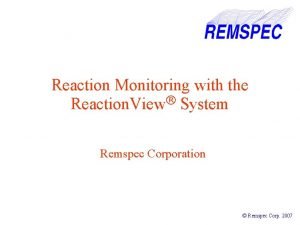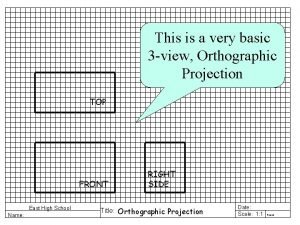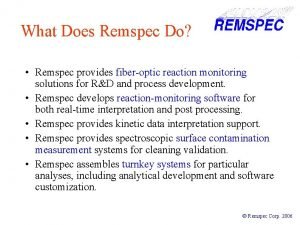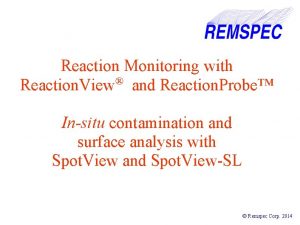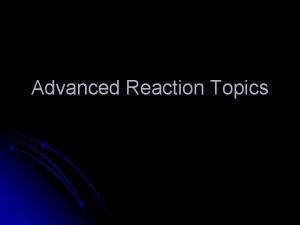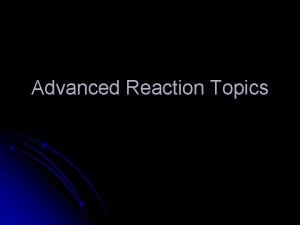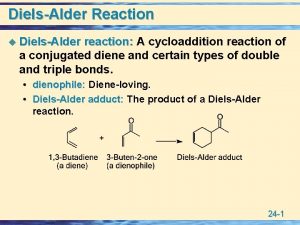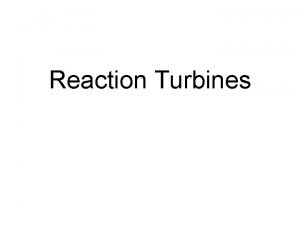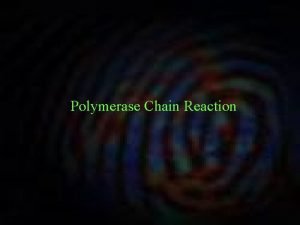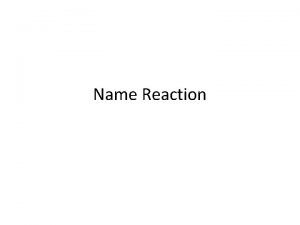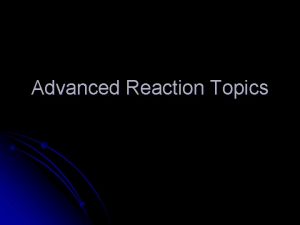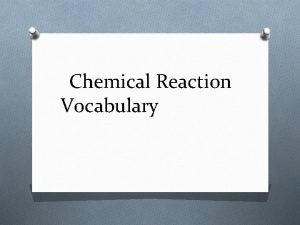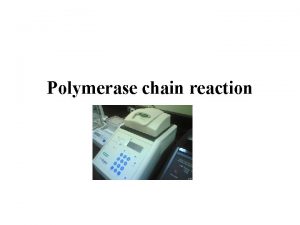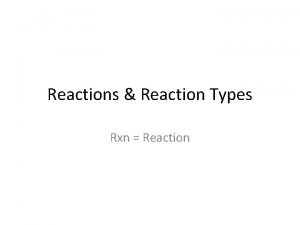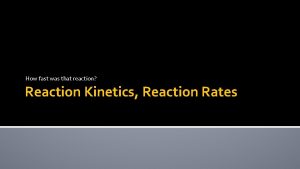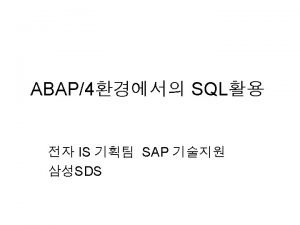Reaction Monitoring with the Reaction View System Remspec













































- Slides: 45

Reaction Monitoring with the ® Reaction. View System Remspec Corporation © Remspec Corp. 2007

Remspec Corporation • Remspec has been manufacturing and selling mid-IR fiber optics for fourteen years. • We have sold over 200 fiber-optic probes and systems to academic and industrial customers all over the world. • We have more experience with mid-IR fiber optics than any other company. • Our software is designed by synthetic chemists to be used by chemists, and is written by in-house software staff. We can provide fully customized software. • Our experienced scientific staff provides full support for applications development. © Remspec Corp. 2007

Reaction. View® Compact FTIR, 35 lb, 1 ft 2 footprint Range 900 -5000 cm-1 ATR and transmission heads fit wide range of reactors Full control and display software on a laptop 20 hr detector dewar for overnight experiments © Remspec Corp. 2007

Reaction. View-4 The four-channel version of Reaction. View allows four probes to be used at once on one spectrometer. Ideal for use with parallel reactor arrays. © Remspec Corp. 2007

Modular Systems Remspec systems are fully modular Sampling heads for high or low temperature, high pressure, corrosive solvents Replaceable ATR crystals for standard conditions, high and low p. H, corrosive conditions Transmission head for very low concentrations Only the head is changed for changing conditions or different types of reactor port © Remspec Corp. 2007

Mid-IR Probes with interchangeable heads Liquid transmission head Fiber-optic probe with cables ATR head (with Zn. Se crystal) © Remspec Corp. 2007

ATR Head • A range of materials can be used (Zn. Se is shown) • Good, general-purpose probe • Sensitive down to about 0. 1 wt. % of most analytes • Works in all solvents, including water • Stainless steel* probe, shaft graphite-filled Teflon® seals, and inert crystal materials make the probe corrosion-resistant. *Hastelloy is available for extreme conditions © Remspec Corp. 2007

Transmission Head The Liquid Transmission Head lowers the detection limit to <0. 1 m. M. It is a double-pass transmission cell with a mirror wall. It can only be used in solvents that have low mid. IR absorbance (e. g. hexane, acetonitrile, methylene chloride, THF); suspended solids can interfere with performance. © Remspec Corp. 2007

Sampling Heads: High Temperatures High Temperature Head Gas cooled (air or nitrogen) ATR or Transmission -100ºC to >200ºC 15 mm OD Available with chemically resistant polymer end for low heat transfer © Remspec Corp. 2007

In-Situ Spectroscopy at High Pressures High Pressure Head 9/16” HIP or 1/2” Dynisco fittings P > 200 bar ATR or Transmission Gas cooled (air or nitrogen), -100ºC to >200ºC © Remspec Corp. 2007

Calibration: Mid-IR Spectrum of Phenyl Isocyanate in Acetone © Remspec Corp. 2007

Calibration: Curve Fitting of 2200 -2380 cm-1 Region in Mid-IR Spectrum of Phenyl Isocyanate 2283 cm-1 2261 cm-1 © Remspec Corp. 2007

Phenyl Isocyanate in Acetone © Remspec Corp. 2007

Phenyl Isocyanate in Acetone © Remspec Corp. 2007

Viz. IR™ Software Can collect a single dataset for 3. 5 days at one spectrum per minute (5000 spectra) Viz. IR includes a Control Panel for setting the resolution and timing of data collection during an experiment, as well as Start and Stop buttons. The display windows show a 3 D picture of the spectra versus time, and a window for most recent spectra or trend-lines. © Remspec Corp. 2007

Viz. IR Software Trend lines can be set up by eye using the Peak. Picker utility, by typing in a desired wavelength, or by using peak fitting (useful for resolving overlapping peaks). Both products and reactants can be followed. © Remspec Corp. 2007

Viz. IR-Remote™ Software When a Viz. IR experiment is running, the Viz. IRRemote Java applet can be used to view the results in real time across a computer network. Viz. IR-Remote can also be used to compare spectra and trend lines from different channels – in this case, the mid-IR and Raman spectra from the same reactor. © Remspec Corp. 2007

Reaction. Sleuth™ Software Simple trendlines, baseline corrected lines and ratios of lines. Peakfit modeling using multiple peak curve deconvolution and fitting of groups of peaks. Post processing using PCA/Target Transformation (similar to Conc. IRT) for “model free” data analysis Saved Methods © Remspec Corp. 2007

Reaction. Sleuth Software Plots of individual PCA factors and their scores (loadings) © Remspec Corp. 2007

Reaction. Sleuth Software Target transformed “synthetic spectra” and their loadings. © Remspec Corp. 2007

Reaction. Sleuth Software Raw data with synthetic spectra subtracted. This can be useful for identifying side reactions and intermediates. © Remspec Corp. 2007

Example: Crystallisation of a Polymorphic Material Although Remspec mid-IR ATR spectra usually “see” only the solution phase, it is sometimes possible to observe crystallisation when the crystals form against the ATR surface. High thermal conductivity crystals such as Diamond or Si can easily become fouled (coated with crystals) © Remspec Corp. 2007

Reaction. View and Automated Reactors Reaction. View® probes fit conveniently into ports in most automated reactors (e. g. Systag Flexilab, HEL Auto. Mate). Viz. IR has an integrated data server so it can exchange data with the automated reactor software enabling synchronization of the timebase of process and spectroscopic data © Remspec Corp. 2007

Example: Methanolysis of Acetic Anhydride This reaction was carried out in an automated reactor. © Remspec Corp. 2007

Example: Methanolysis of Acetic Anhydride The reactor was filled with methanol and the temperature was raised to 35°C. The intensity of the methanol spectrum changed with temperature. © Remspec Corp. 2007

Example: Methanolysis of Acetic Anhydride Acetic anhydride was added in measured amounts using the reactor control system. The reactor temperature rose because the reaction is exothermic requiring the jacket temperature to drop. © Remspec Corp. 2007

Example: Methanolysis of Acetic Anhydride The change in reactor temperature coincides with changes in the mid-IR spectra of the reactant and the product. © Remspec Corp. 2007

Example: Formation of Ketene Intermediate Reaction. View was used with a low-temperature liquid transmission head to monitor a low-temperature reaction at very low concentrations in a small reactor. Preparation of a ketene intermediate from acetyl chloride by HCl elimination. © Remspec Corp. 2007

Example: Formation of Ketene Intermediate Hunig's base (0. 05 mmoles) in methylene chloride (8 ml) Acetyl chloride (0. 25 mmoles) in methylene chloride (2 ml) added incrementally [approx. 50 μl every 30 minutes] CH 3 COCl Eliminate HCl CH 2=C=O [ketene] © Remspec Corp. 2007

Example: Formation of Ketene Intermediate The “fingerprint” region of the spectrum includes peaks from the starting material (acetyl chloride) and the intermediate product (ketene). © Remspec Corp. 2007

Example: Formation of Ketene Intermediate The real-time display in Viz. IR shows the increase in the acetyl chloride peak when it is added, followed by the increase in ketene as the acetyl chloride is consumed. © Remspec Corp. 2007

Fermentation Monitoring Cloudy, aqueous medium with varying optical density ATR in the mid-IR samples only the liquid phase and is not affected by suspended solids or varying optical density © Remspec Corp. 2007

Fermentation Monitoring Carbon dioxide region A single peak emerging at 2342 cm-1 is characteristic of dissolved CO 2, and a robust calibration has been developed. The neighboring peaks are associated with other forms of CO 2, e. g. contained in small bubbles; these features are hard to calibrate. © Remspec Corp. 2007

Fermentation Monitoring Carbon dioxide region The calibration is based on a peak-fitting model of the CO 2 spectral region. Viz. IR can run the model in real time as spectra are collected, to generate a trendline. The peak at 2342 cm-1 can be calibrated against known dissolved CO 2 concentrations. © Remspec Corp. 2007

Fermentation Monitoring Carbon dioxide region The changes in the CO 2 region are clearly visible in the 3 D display. The blue CO 2 trendline is based on the peak at 2342 cm-1 from the peak-fit model Compare with the simple line based on the intensity at 2342 cm-1. © Remspec Corp. 2007

Fermentation Monitoring Calibration of Trendlines PLS models based on a set of solutions of sucrose, fructose, and glucose, and ethanol can be run in real time. Note that these trendlines are individually autoscaled. © Remspec Corp. 2007

Reaction. View Spectra of Oxidative Oil Degradation Reaction. View dataset from 1000 -4500 cm 1(a baseline correction has been applied to each spectrum). Shows changes between reaction time 420 min. and 800 min. Note emergence of feature centered at approx. 1700 cm-1, the carbonyl region. © Remspec Corp. 2007

Reaction. View Spectra of Oxidative Oil Degradation The emerging carbonyl feature is quite complex. The Viz. IR software that runs Reaction. View can be used to set up trendlines based on peak-fitting models. © Remspec Corp. 2007

Peak-Fit Model of Reaction. View Data Model is based on the final spectrum in the set. Viz. IR calculates trendlines by fitting the model against each spectrum in the set, either in realtime or in postprocessing. © Remspec Corp. 2007

Trendlines from Oil Degradation Spectra The peak areas from the model of the carbonyl region are graphed against time (in minutes). It is possible to distinguish different times of onset, and different rates of emergence for different peaks. The peaks at 1777 and 1736 cm-1 grows more rapidly that the others.

Synthetic Spectra Calculated from Oil Degradation Data When Remspec's Reaction. Sleuth software is used to calculate “synthetic spectra” from the dataset, the two spectra shown in blue and green are obtained. The red trace is the spectrum from the end of the Reaction. View run. © Remspec Corp. 2007

Trendlines Calculated for Synthetic Spectra The two synthetic spectra show different trending behavior. This confirms the conclusion from the peakfit trends that two distinct processes are taking place at different rates, and at different induction times. Process 1: starts around 680 minutes, relatively fast. Process 2: starts around 700 minutes, relatively slow. © Remspec Corp. 2007

Mid-IR and Raman Together: Reaction. View® and Verax™ Reaction. View's mid-IR probes and Verax Raman. Probes fit easily into the same reactor. In this example, the hydrolysis of acetic anhydride was monitored. Acetic anhydride was added to vigorously stirred water. © Remspec Corp. 2007

Mid-IR and Raman Together: Ram. IR™ Software Separate window for each channel – mid-IR and Raman – with full 3 D displays and trending Control panel for setting up experiments and synchronising data collection © Remspec Corp. 2007

In Summary Remspec manufactures and supplies mature well supported systems with a wide choice of sampling options that are easy to use and provide repeatable data. Remspec provides specialized software that is optimized specifically for reaction monitoring and the analysis of reaction data. © Remspec Corp. 2007
 Remspec
Remspec What is operating system
What is operating system Hình ảnh bộ gõ cơ thể búng tay
Hình ảnh bộ gõ cơ thể búng tay Frameset trong html5
Frameset trong html5 Bổ thể
Bổ thể Tỉ lệ cơ thể trẻ em
Tỉ lệ cơ thể trẻ em Voi kéo gỗ như thế nào
Voi kéo gỗ như thế nào Glasgow thang điểm
Glasgow thang điểm Hát lên người ơi alleluia
Hát lên người ơi alleluia Các môn thể thao bắt đầu bằng tiếng bóng
Các môn thể thao bắt đầu bằng tiếng bóng Thế nào là hệ số cao nhất
Thế nào là hệ số cao nhất Các châu lục và đại dương trên thế giới
Các châu lục và đại dương trên thế giới Cong thức tính động năng
Cong thức tính động năng Trời xanh đây là của chúng ta thể thơ
Trời xanh đây là của chúng ta thể thơ Mật thư tọa độ 5x5
Mật thư tọa độ 5x5 101012 bằng
101012 bằng độ dài liên kết
độ dài liên kết Các châu lục và đại dương trên thế giới
Các châu lục và đại dương trên thế giới Thể thơ truyền thống
Thể thơ truyền thống Quá trình desamine hóa có thể tạo ra
Quá trình desamine hóa có thể tạo ra Một số thể thơ truyền thống
Một số thể thơ truyền thống Cái miệng xinh xinh thế chỉ nói điều hay thôi
Cái miệng xinh xinh thế chỉ nói điều hay thôi Vẽ hình chiếu vuông góc của vật thể sau
Vẽ hình chiếu vuông góc của vật thể sau Biện pháp chống mỏi cơ
Biện pháp chống mỏi cơ đặc điểm cơ thể của người tối cổ
đặc điểm cơ thể của người tối cổ Thứ tự các dấu thăng giáng ở hóa biểu
Thứ tự các dấu thăng giáng ở hóa biểu Vẽ hình chiếu đứng bằng cạnh của vật thể
Vẽ hình chiếu đứng bằng cạnh của vật thể Vẽ hình chiếu vuông góc của vật thể sau
Vẽ hình chiếu vuông góc của vật thể sau Thẻ vin
Thẻ vin đại từ thay thế
đại từ thay thế điện thế nghỉ
điện thế nghỉ Tư thế ngồi viết
Tư thế ngồi viết Diễn thế sinh thái là
Diễn thế sinh thái là Các loại đột biến cấu trúc nhiễm sắc thể
Các loại đột biến cấu trúc nhiễm sắc thể Các số nguyên tố là gì
Các số nguyên tố là gì Tư thế ngồi viết
Tư thế ngồi viết Lời thề hippocrates
Lời thề hippocrates Thiếu nhi thế giới liên hoan
Thiếu nhi thế giới liên hoan ưu thế lai là gì
ưu thế lai là gì Sự nuôi và dạy con của hươu
Sự nuôi và dạy con của hươu Khi nào hổ mẹ dạy hổ con săn mồi
Khi nào hổ mẹ dạy hổ con săn mồi Hệ hô hấp
Hệ hô hấp Từ ngữ thể hiện lòng nhân hậu
Từ ngữ thể hiện lòng nhân hậu Thế nào là mạng điện lắp đặt kiểu nổi
Thế nào là mạng điện lắp đặt kiểu nổi Orthographic drawing title block
Orthographic drawing title block Under what conditions, a sectional view is preferred?
Under what conditions, a sectional view is preferred?
